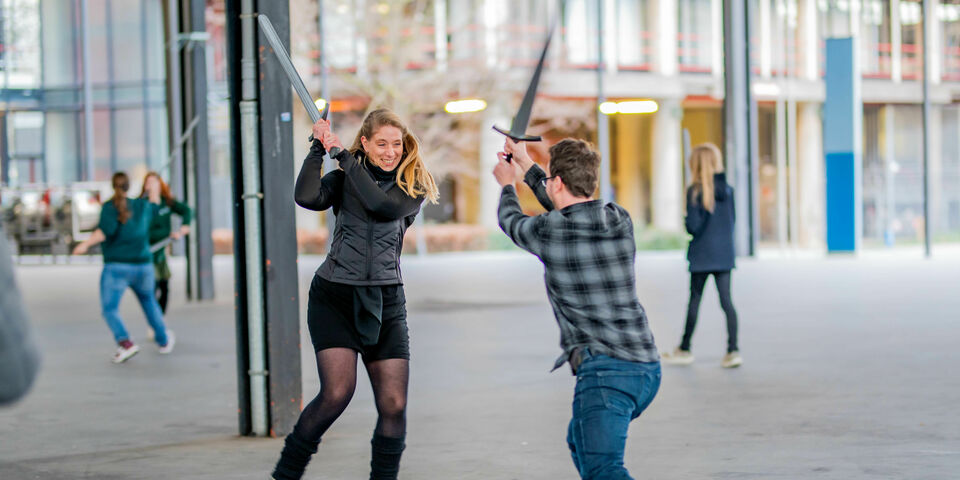Cursor goes course-hopping | Swordfighting
There’s a lot to learn at TU/e outside the regular lectures. This time, Cursor joined a swordfighting training taught by students of The Knights of the Kitchen Table. Fortunately there’s no danger involved, as special LARP swords are used that are made of foam rubber with a fiber glass core.
Carrying the swords under our arms, we walk from the Knights room in the basement of Luna to the MetaForum market hall. It’s chilly out, but “because of the swords, which are over a yard in length, we need a place with high ceilings to train,” Knights chair Laura Sentjens says.
Knights of the Kitchen Table is an association for students that like boardgames (such as the entire range created by 999 Games), roleplaying games (such as Dungeons & Dragons) and/or live action role-playing, or LARP for short.
The LARP subculture consist of people that like to visit special events (such as Ravenskeep and Drachenfest) to immerse themselves in other worlds (mostly fantasy-based) or other eras, playing roles such as elves or knights. The Knights’ biweekly swordfighting training on Thursday night is directly related to this subculture, as swordfighting is often part of the program at LARP events.
Swishing
As mentioned, it’s unlikely for blood to flow at a LARP swordfight, because the fiber glass core of the sword is covered in a foam rubber shell. But you can still really hurt your opponent if you take a big swing at them.
Which is why aiming for the head or the ‘nether region’ is forbidden, says Ronald Smits, who teaches tonight’s training together with Lena Wildervanck. He adds: “If you really hear the sword swishing through the air, you can safely assume you’re using too much force.”
To ‘get a feel for it’, I get to practice on the rock hard arm of veritable mountain of a student Joost Vossen. At first I hold back a little bit, but the second time I really let fly. “Something in between,” my guinea pig says, rubbing his biceps. Whoops.
While Ronald and Lena keep on practicing with the group, fellow trainer Mennolt van Alten draws me aside to teach me the basics of swordfighting.
You grab the sword with the index finger and thumb of your dominant hand (the right one in my case), just below the crossguard (the little horizontal bar between the hilt and the blade). With the other hand you support the hilt, which enables you to quickly spin the sword around and surprise your opponent.
Footwork
But the basis of swordfighting is in the footwork, Mennolt teaches me. Feet placement can make the difference between striking someone or being struck. Your life’s worth three points, so if you’re struck three times you’re ‘dead’, which means you have to run back and forth to the staircase in the market hall to earn a new life. I’m running all the time, because the footwork that looks so obvious with the others turns out to be a lot more complex when I try it.
Mennolt tells me about a number of sword strikes with impressive-sounding German names. Why German? “For these trainings we use a book based on manuscripts from Germany, which date back to the fifteenth century. The authors, Lichtenauer and his successor Meyer, were worried that young people in those days were no longer taught the skill of swordfighting.”
That’s why they wrote a series of manuals, which still come in handy half a millennium later. That is, “a lot of the techniques that are described are aimed at hitting the other party on the head with maximum force,” which is exactly what the Knights are wisely trying to avoid.
There are groups that take a more authentic approach to swordfighting, with real steel swords and harness-like protection, Laura tells me. “They are involved in Historical European Martial Arts, or HEMA, for example. A lot of historians play this sport to experience and rediscover fighting techniques from old manuscripts.” Interesting as this sounds, it’s probably more of a thrill than this rookie can handle.
Dueling
After a cookie break, Ronald and Lena address the technical side of things: how do you emerge victorious if you and your opponent are sword to sword (a so-called ‘binding’). And then it’s time for the real deal. First we fight a line battle in two teams standing opposite another, which just for a moment makes me feel like I’m on the set of a swashbuckling movie, flanked by my comrades-in-arms.
After this, we fight duels in the middle of a big circle. Whoever is struck is out, and gets to decide the next opponent. An “En garde … près … allez!” and the fight begins. The swordfighters pull out all stops: glaring at the opponent, diversionary tactics (“Your pants are dropping!”) and impressive technical feats, like swordfighting while squatting (‘the frog’).
I’m trying to lay low until I’m the last ‘survivor’, at which point there’s nothing else to do but step into the circle. Technical skills aren’t my forte, but I’m enjoying myself immensely! Concentrating on the opponent’s swords puts me in the zone and for a moment I’m in the Middle Ages, until I see a skater flash by in the corner of my eye, bringing me straight back to 2023. I’m momentarily bummed out. Should I come back in two weeks?
In the ‘Cursor goes course-hopping’ feature, our editors will take part in the various training sessions, courses and workshops that TU/e offers throughout the year with the aim of allowing students and staff members to increase their knowledge and skills in a variety of fields. If you happen to offer a course, training session or workshop yourself that might be of interest to this feature, or if you know of any such event, don’t hesitate to contact Cursor’s editorial board.






Discussion